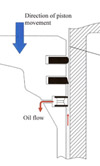The Piston and Ring in Harmony
 A piston can’t do a good job unless it has a good ring pack, and likewise, a good ring pack will be useless without a good piston.
A piston can’t do a good job unless it has a good ring pack, and likewise, a good ring pack will be useless without a good piston.
Most people will appreciate that the piston ring exists principally to reduce the amount of combustible gases escaping into the crankcase, but I’m afraid there is a lot more to it than that simple statement. To start off with, the seal has to move at a speed of something up to 5000 ft per minute (26 m/sec) and cope with piston
temperatures of 300 deg C and more. In combination the ring pack also stabilises the piston as it moves up and down the bore minimising the chance of point contact on the piston top land and lower skirt. As well as controlling the blow-bye going down the gap between piston and cylinder and conducting around three quarters of the heat in the piston into the cylinder block, it also has to control the engine lubricant travelling in the opposite direction and do all this with minimum contact force and do it reliably and repeatedly for hours on end.
Fortunately we do not expect a single ring to do all of this. This would be expecting too much and although some predominately sprint racing applications use only two rings, conventional pistons tend to use three rings. To achieve this over the years, many different designs of rings have been developed often in response to particular characteristics or problems in the engine and or piston design.

The top ring is designed purely as a compression ring. Rectangular or ‘L’ shaped ‘Dykes’ rings all have their applications but it is the barrel faced top ring that is favoured in most racing power units. Giving purely line contact around the circumference of the bore, this design would appear to give the best sealing pressure for any given initial radial tension. At light load, this radial tension should be sufficient to seal the gap but at higher loads it is the gas pressure itself seeping into the void behind the ring that does the work and is the reason why the side clearance between ring and piston can be highly critical. The barrel shape is quicker to bed in and can also control the oil flow more effectively. Barrel profiles can also be symmetrical if desired and can enhance oil control under certain circumstances. While a few years ago flash coatings around 2-3 microns of titanium nitride may have been optimum, today, and depending on your bore surface, these are becoming increasingly replaced by DLC.
The second compression ring has more of a dual role. Generally in the form of some kind of scraper ring, it completes the seal, trapping any gas bypassing the top ring on the power stroke, and in addition, supports the oil control ring in removing or scraping off any excess oil missed by the oil control ring below it. Usually a rectangular ring with the outer face tapered such that the bottom edge contacts the cylinder, the downward stroke removes the excess oil with the upward stroke in theory riding over any oil on the bore.
Oil control rings can be one, two or even three piece affairs, with upper and lower side rails bordering some kind of corrugated spacer and remove any excess oil from the bore and return it through the piston back to the crankcase.
But rather like a duet, only when the pistons and rings are working in harmony, can the music begin.
Written by John Coxon.